Use of force - Study guides, Class notes & Summaries
Looking for the best study guides, study notes and summaries about Use of force? On this page you'll find 29 study documents about Use of force.
Page 2 out of 29 results
Sort by
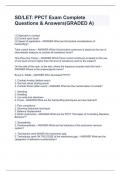
-
SD/LET: PPCT Exam Complete Questions & Answers(GRADED A)
- Exam (elaborations) • 8 pages • 2024
-
Available in package deal
-
- $11.99
- + learn more
(1) Approach to contact (2) Control upon touch (3) Speed of application - ANSWER What are the tactical considerations of handcuffing? Total control theory - ANSWER Which force/control continuum is based on the use of intermediate weapons to counter all resistance/ force? One-Plus-One Theory - ANSWER Which force/ control continuum is based on the use of one level of force higher than the level of resistance used by the subject? On the side of the neck, to the rear, where the trapeziu...
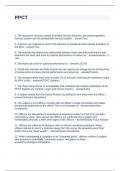
-
PPCT EXAM BUNDLE
- Package deal • 12 items • 2024
-
- $34.99
- + learn more
Exam (elaborations) PPCT GUIDE QUESTIONS AND ANSWERS CORRECT Exam (elaborations) PPCT Handcuffing Questions and Answers 100% correct Exam (elaborations) Flat rock PPCT Questions and Answers Exam (elaborations) PPCT-USE OF FORCE QUESTIONS AND ANSWERS 2024 Exam (elaborations) PPCT Control Principles Chapter 2 Questions with Solutions 2024
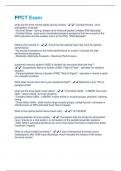
-
PPCT Exam Questions + Answers Graded A+
- Exam (elaborations) • 7 pages • 2024
- Available in package deal
-
- $7.99
- + learn more
what are the three mental states during combat - ️️~Combat Anxiety - prior, anticipation of danger ~Survival Stress - during, deadly force threat perception initiates SNS discharge ~Combat Stress - post event mental/physiological symptoms that are a result of the SNS activation and the sudden return to the PNS. "PNS Backlash" What is the inverted U - ️️~Examines the optimal heart rate zone for optimal performance. ~As arousal increases so will motor performance to a point, i...
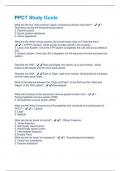
-
PPCT Study Guide Questions And Answers Rated 100% Correct
- Exam (elaborations) • 6 pages • 2024
- Available in package deal
-
- $8.39
- + learn more
What are the four most common types of resistance officers encounter? - ️️1. Resistance during the handcuffing procedure 2. Passive actions 3. Escort position resistance 4. Active aggression What are the three energy systems the human body relies on? Describe them. - ️️1. ATP/PC System- Small energy bundles stored in the muscles. 2. Lactic Acid System- Once the ATP system is depleted, the LAS will act as afterburn fuel. 3. Aerobic System- Once the LAS is depleted, the AS becomes...
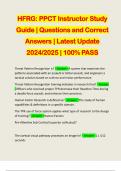
-
HFRG: PPCT Instructor Study Guide | Questions and Correct Answers | Latest Update 2024/2025 | 100% PASS
- Exam (elaborations) • 14 pages • 2024
- Available in package deal
-
- $11.99
- + learn more
HFRG: PPCT Instructor Study Guide | Questions and Correct Answers | Latest Update 2024/2025 | 100% PASS Threat Pattern Recognition is? - Answer -A system that examines the patterns associated with an assault or lethal assault, and engineers a tactical solution based on science and motor performance. Threat Pattern Recognition training indicates in research that? - Answer -Officers who received proper TPR decrease their Reaction Time during a deadly force assault, and enhance their preci...
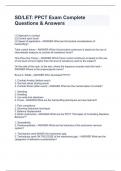
-
SD/LET: PPCT Exam Complete Questions & Answers
- Exam (elaborations) • 8 pages • 2024
-
Available in package deal
-
- $10.99
- + learn more
(1) Approach to contact (2) Control upon touch (3) Speed of application - ANSWER What are the tactical considerations of handcuffing? Total control theory - ANSWER Which force/control continuum is based on the use of intermediate weapons to counter all resistance/ force? One-Plus-One Theory - ANSWER Which force/ control continuum is based on the use of one level of force higher than the level of resistance used by the subject? On the side of the neck, to the rear, where the trapeziu...

-
PPCT Complete Questions & Answers(2024/2025)
- Exam (elaborations) • 8 pages • 2024
-
Available in package deal
-
- $11.99
- + learn more
Four specific triggers activate the SNS - ANSWER Objective threat perceptions, objective fear perceptions, physical exhaustion, and startle response Objective threat perceptions - ANSWER Include the fact that the threat is within close proximity, the time needed to control the threat is minimal, the person is not confident with his/her abilities, or the fact that the threat perception is a new experience Objective fear perception - ANSWER Include a person having fear of death, injury, kill...
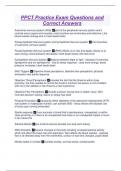
-
PPCT Practice Exam Questions and Correct Answers
- Exam (elaborations) • 15 pages • 2024
-
- $9.99
- + learn more
Autonomic nervous system (ANS) part of the peripheral nervous system and it controls many organs and muscles, most functions are involuntary and reflective. Like blood vessles change size or heart beats faster Parasympathetic Nervous system and Sympathetic Nervous system Two branches of autonomic nervous system Parasympathetic Nervous system (PNS) Allows us to rest and digest, allows us to save energy, blood pressure decreases, heart beats slower with less force Sympathetic Nervous System Bal...
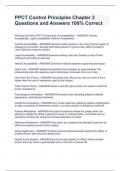
-
PPCT Control Principles Chapter 2 Questions and Answers 100% Correct
- Exam (elaborations) • 3 pages • 2024
-
Available in package deal
-
- $10.49
- + learn more
PPCT Control Principles Chapter 2 Questions and Answers 100% Correct PPCT Control Principles Chapter 2 Questions and Answers 100% Correct PPCT Control Principles Chapter 2 Questions and Answers 100% Correct PPCT Control Principles Chapter 2 Questions and Answers 100% Correct What are the three PPCT Components of Acceptability? - ANSWER-Tactical Acceptability; Legal Acceptability; Medical Acceptability Tactical Acceptability - ANSWER-Develop system based on the most common types of resistance ...
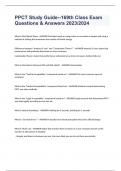
-
PPCT Study Guide--169th Class Exam Questions & Answers 2023/2024
- Exam (elaborations) • 16 pages • 2023
-
Available in package deal
-
- $9.99
- + learn more
PPCT Study Guide--169th Class Exam Questions & Answers 2023/2024 What is Fluid Shock Wave - ANSWER-Principle based on using motor nerve points as targets and using a method of striking that maximizes the transfer of kinetic energy Difference between "Inverted U Law" and "Catastrophe Theory"? - ANSWER-Inverted U Law: states that performance will gradually deteriorate as stress increases Catastrophe Theory: states that performance will plummet as stress increases--bottom falls out ...

Study stress? For sellers on Stuvia, these are actually golden times. KA-CHING! Earn from your study resources too and start uploading now. Discover all about earning on Stuvia


